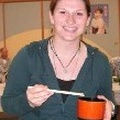It’s August fourth, 2006, two o’clock in the afternoon. My friend’s mother is wrapping my torso with a white cloth called a sarashi. Breathing and sitting become a bit more difficult as she uses all her strength to make it as tight as possible; perhaps sarashi means corset in Japanese. But it’s worth it, when she’s done it looks very kakko ii (cool, flash, stylin’). Next, I make my hair as big as possible using hairspray as if I was in the 80’s. I put on my traditional black festival pants, tabi (cloth shoes with a partition between the first two toes), happi (a short kimono robe), and obi (a special belt for the happi). It’s four o’clock and my friends and I are ready for the Tachi Nebuta Matsuri, a famous festival in Aomori.
We grab our bachi (taiko drum sticks) and meet up with the rest of the group before the parade starts. Everyone is excited; the atmosphere is full of electricity. People are drinking beer, looking at the neighboring floats, and practicing different instruments including the flute, taiko drums, and kane (hand held symbols). We group together one last time to hype ourselves up and get focused.
At six o’clock the parade finally starts. There are thousands of people lining the streets of this normally quiet town. Food vendors are at every corner offering ice cream, takoyaki (fried octopus bread balls that are so delicious!), chocolate dipped bananas, yakisoba (fried noodles), and grilled meat on a stick. Everyone starts cheering as the first float makes its way down the street. The floats are made to look like traditional Japanese paintings of women with children, samurai with red faces, and animals straight out of old Japanese fairy tales. Some of the floats are four stories high and just take your breath away.
Between the floats are various groups in different costumes playing the traditional Tachi Nebuta song or performing traditional dances. There are no words, instead people yell out “Yatte mare, yatte mare” (which means “Let’s do it!”) and the audience yells it back. Occasionally there are pauses in the parade so that the performers can interact with the audience. The audience cheers even louder and the performers get reenergized.
My group is seventh in the line of the groups and floats. We have about forty people and are playing the traditional music. There is no age limit for participants, so there are people as young as three and as old as seventy-five and then everything in between. As our group leaves the starting line, everyone picks up their instrument (flute, taiko drums, or kane) and starts playing. The taiko I play is too large to carry, so it is holstered onto a float that is pushed by other members of the group. Walking and playing the taiko at the same time is difficult, but I don’t think about it because of all the energy I get from the audience.
The parade continues for two hours and at the end of it we are exhausted! We go back to the parade hall and receive free onigiri (rice ball) and drinks. Everyone is happy that it went well. But it’s only the first day of a five day event. By the end of the five days, we are truly exhausted and have probably lost at least five pounds with all of the activity. We have an Otsukaresama (this literally means “one that is tired”) party and say our goodbyes until next year. It was one of the most enjoyable events I’ve done in Japan.
Well, it’s that time of year again! The Tachi Nebuta Matsuri is only three weeks away. My group has been getting together for practice every week since April. We only have three more practices, but I already feel like an old pro. This will actually be my fifth time to participate in a local festival and I love it. It’s a great way to get to know the locals and get familiar with different aspects of Japanese culture. I sometimes find that Japanese culture is stiff and the work environment allows for very little self-expression. However, the matsuri is when everyone lets their hair down and just has a good time.
Almost every local area in Japan has a festival. The meaning of the festival changes depending on the town and what they are celebrating. They could be celebrating the change in season, a national holiday, or praying for a good harvest. Festivals are sponsored by shrines, temples, or local community officials. But they often have the feeling of a local county fair. They are usually accompanied by an impressive fireworks display before or after the festival. It’s also one of the few times a year that men and women will wear traditional Japanese kimono or yukata (summer kimono). I wore a yukata for the first time last year for the local festival and it was great fun.
One of the purposes of the JET program is to encourage cultural exchange and understanding. Part of that includes understanding our cultural differences and how to overcome them. However, a friend of mine said that it’s more important to focus on our similarity and build true friendships based on our shared humanity. Participating in the local festival has helped me do that more than anything else in Japan. In such a relaxed environment it’s easy to see each other as friends instead of people from two different countries. There’s nothing like laughter, music, and sweat to bring people together. I can’t wait for the next festival so we can do it all over again!
© 2007 Allison Reed





